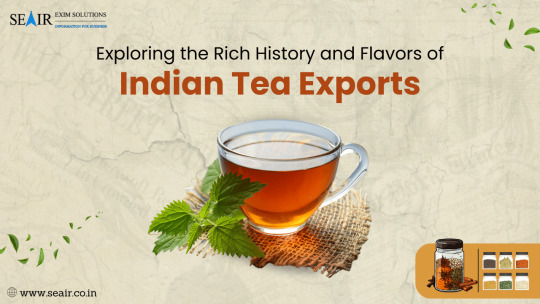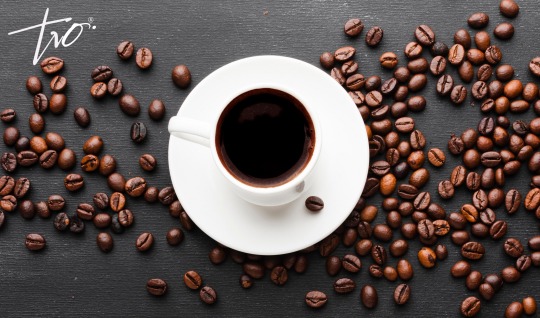#tea exporters
Explore tagged Tumblr posts
Text
Top 10 Tea Exporting Countries in the World 2023-24
There are many tea exporter countries such as Sri Lanka, India and Kenya, but one of the biggest tea exporter in the world is China. Today, In this blog, we will explore the detailed list of top tea exporter countries with their export values and updated tea export data.
0 notes
Text
Learn the essential steps for exporting tea from India and start sharing the flavors of India with the world

0 notes
Text
#Tea exports from India#India tea export#tea exporting countries#Tea exporters in India#Tea exporters
0 notes
Text
Discover comprehensive guide to tea exports from India. Learn about top tea-producing states, major exporters, and global market trends. Access up-to-date tea export data and find reliable tea suppliers in India with Seair Exim Solutions.
#Tea exports from India#tea export data#tea export#tea exporters in India#tea exporters#tea hs code#India tea export#top tea exporters in india
0 notes
Text
https://www.seair.co.in/blog/tea-exports-from-india.aspx

Discover the journey of Indian tea exports, from its origins in China to becoming a cultural staple in India. Learn about top tea-producing regions, current export statistics, leading exporters, and market insights. Explore more at Seair Exim Solutions.
#Tea exports from India#tea export data#tea export#tea exporters in India#tea exporters#highest tea producing country#largest exporter of tea in the world#tea hs code#India tea export#tea suppliers in india#top 10 tea importing countries in the world#top tea exporters in india
0 notes
Text

Top 10 Tea Exporters | tea exporter
Explore the biggest top 10 tea exporter countries or companies glbally | biggest tea producer countries | most popular types of tea
0 notes
Text
The tea sector is a billion dollar industry that can support economies and contribute to sustainable food systems.

In many developing countries, the tea sector contributes significantly to rural development, poverty reduction and food security, representing, in several cases, a major source of income and employment for millions of poor families. The global tea production amounts annually to over USD 17 billion, while world tea trade is valued at about USD 9.5 billion, accounting for an important source of export earnings. One key characteristic about tea is that smallholders are responsible for 60 percent of world production. Importantly, tea provides productive jobs in rural areas, which empowers households and communities to meet their food security needs and improve their nutritional status. World tea per capita consumption increased by 2.5 percent over the last decade, with marked expansions in tea producing countries. Developing and emerging economies have been driving the growth in demand, with East Asia, Africa, Latin America and the Caribbean, and the Near East leading the expansion Several factors influence demand for tea, including prices and income variables, demographics such as age, education, occupation, and cultural background. Growing consumption of tea in producing countries, driven by population and income growth, has translated in a decrease of exportable production over the past two decades. Nevertheless, per capita consumption remains low in these countries compared to importing markets, and greater efforts should be directed at expanding demand to explore prevailing market opportunities.
International tea market: market situation, prospects and emerging issues.
0 notes
Text

They like to go out for tea together, shes in for the pastries while hes there for the nice tea brews
#sometimes coffee too!#i like to think coffee is more rare in yharnam bc its export material#so they usually go out for tea#they are in their sunday best here#roms brooch was a gift from him ehe#SORRY I LOVE THEEEMMMMM#art#bloodborne#bloodborne fanart#micorom#bloodborne micolash#bloodborne rom#micolash host of the nightmare#rom the vacuous spider
61 notes
·
View notes
Text
Nothing in the past, moreover, gave any cause to suspect ginseng’s presence so far away. Or even closer by: since antiquity, for well over a millennium, the ginseng consumed in all of East Asia had come from just one area -- the northeast mountainous lands straddling Manchuria and Korea. No one had found it anywhere else. No one was even thinking, now, to look elsewhere. The [...] [French traveler] Joseph-Francois Lafitau didn’t know this. He had been [...] visiting Quebec on mission business in October of 1715 [...]. He began to search for ginseng. [...] [T]hen one day he spotted it [...]. Ginseng did indeed grow in North America. [...]
Prior to the nuclear disaster in the spring of 2011, few outside Japan could have placed Fukushima on a map of the world. In the geography of ginseng, however, it had long been a significant site. The Edo period domain of Aizu, which was located here, had been the first to try to grow the plant on Japanese soil, and over the course of the following centuries, Fukushima, together with Nagano prefecture, has accounted for the overwhelming majority of ginseng production in the country.
Aizu’s pioneering trials in cultivation began in 1716 – by coincidence, exactly the same year that Lafitau found the plant growing wild in the forests of Canada. [...]
---
Since the 1670s the numbers of people [in Japan] clamoring for access to the drug had swelled enormously, and this demand had to be met entirely through imports. The attempt to cultivate ginseng in Aizu -- and soon after, many other domains -- was a response to a fiscal crisis.
Massive sums of silver were flowing out of the country to pay for ginseng and other drugs [...]. Arai Hakuseki, the chief policy maker [...], calculated that no less than 75% of the country’s gold, and 25% of its silver had drained out of Japan [to pay for imports] [...]. Expenditures for ginseng were particularly egregious [...]: in the half-century between 1670s through the mid-1720s that marked the height of ginseng fever in Japan, officially recorded yearly imports of Korean ginseng through Tsushima sometimes reached as much as four to five thousand kin (approx. 2.4–3 metric tons).
What was to be done? [...] The drain of bullion was unrelenting. [...] [T]he shogunate repeatedly debased its currency, minting coins that bore the same denomination, but contained progressively less silver. Whereas the large silver coin first issued in 1601 had been 80% pure, the version issued in 1695 was only 64% silver, and the 1703 mint just 50%. Naturally enough, ginseng dealers in Korea were indifferent to the quandaries of the Japanese rulers, and insisted on payment as before; they refused the debased coins. The Japanese response speaks volumes about the unique claims of the drug among national priorities: in 1710 (and again in 1736) a special silver coin of the original 80% purity was minted exclusively for use in the ginseng trade. [...]
[T]he project of cultivating ginseng and other medicines in Japan became central to the economic and social strategy of the eighth shogun Yoshimune after he assumed power in 1716. [...]
---
China and Korea were naturally eager to retain their monopolies of this precious commodity, and strictly banned all export of live plants and seeds. They jealously guarded as well against theft of mature roots: contemporary Chinese histories, for example, record that the prisons of Shenjing (present day Shenyang) overflowed with ginseng poaching suspects. So many were caught, indeed, that the legal bureaucracy couldn’t keep up.
In 1724, the alarming numbers of suspected poachers who died in prison while awaiting trial led to the abandonment of the regular system of trials by judges dispatched from Beijing, and a shift to more expeditious reviews handled by local officials. [...]
Even in 1721. the secret orders that the shogunate sent the domain of Tsushima called for procuring merely three live plants [...]. Two other forays into Korea 1727 succeeded in presenting the shogun with another four and seven plants respectively. Meanwhile, in 1725 a Manchu merchant in Nagasaki named Yu Meiji [...] managed to smuggle in and present three live plants and a hundred seeds. [...]
Despite its modest volume, this botanical piracy eventually did the trick. By 1738, transplanted plants yielded enough seeds that the shogunate could share them with enterprising domains. [...] Ginseng eventually became so plentiful that in 1790 the government announced the complete liberalization of cultivation and sales: anyone was now free to grow or sell it.
---
By the late eighteenth century, then, the geography of ginseng looked dramatically different from a century earlier.
This precious root, which had long been restricted to a small corner of the northeast Asian continent, had not only been found growing naturally and in abundance in distant North America, but had also been successfully transplanted and was now flourishing in the neighboring island of Japan. […]
---
Colonial Americans, for their part, had developed their own new addiction: an unquenchable thirst for tea. […] This implacable need could have posed a serious problem. [...] [I]ts regular consumption was a costly habit.
Which is why the local discovery of ginseng was a true godsend.
When the Empress of China sailed to Canton in 1784 as the first ship to trade under the flag of the newly independent United States, it was this coveted root that furnished the overwhelming bulk of sales. Though other goods formed part of early Sino-American commerce – Chinese porcelain and silk, for example, and American pelts – the essential core of trade was the exchange of American ginseng for Chinese tea. [...]
---
Yoshimune’s transplantation project had succeeded to the point that Japan actually became a ginseng exporter. As early as 1765, Zhao Xuemin’s Supplement to the compedium of material medica would note the recent popularity of Japanese ginseng in China. Unlike the “French” ginseng from Canada, which cooled the body, Zhao explained, the “Asian” ginseng (dongyang shen) from Japan, like the native [Korean/Chinese] variety, tended to warm. Local habitats still mattered in the reconfigured geography of ginseng. [...]
What is place? What is time? The history of ginseng in the long eighteenth century is the story of an ever-shifting alchemical web. [...] Thanks to the English craving for tea, ginseng, which two centuries earlier had threatened to bankrupt Japan, now figured to become a major source of national wealth [for Japan] .
---
Text by: Shigehisa Kuriyama. “The Geography of Ginseng and the Strange Alchemy of Needs.” In: The Botany of Empire in the Long Eighteenth Century, edited by Yota Batsaki, Sarah Burke Cahalan, and Anatole Tchikine. 2017. [Bold emphasis and some paragraph breaks/contractions added by me.]
#all kinds of fun stuff smuggling piracy biogeography medicinal tea shogunates secret orders#the irony of emerging US empire beginning relationship with china based on export of american ginseng which europeans hadnt known existed#the irony of japan quickly transitioning from almost being bankrupted by ginseng to becoming a ginseng exporter#the importance of local habitats and smallscale biogeography despite the global scale of imperial trade#the french cartographer in 1711 in manchuria who had never been to canada but correctly predicted ginseng might grow there#abolition#ecology#imperial#colonial#geographic imaginaries#ecologies#multispecies#tidalectics#archipelagic thinking#geography of ginseng
106 notes
·
View notes
Photo



blaine didnt even tell their family they were going out they just booked it out of the house and down thes treet
spader, not having a great night: it’s not FAIR-- why aren’t you HERE...
blaine: five minutes. spader: w- what? blaine: it takes me five minutes to run to your house. five minutes.
spader: yeah im calm now you didnt have to do that
spader, building up a fire for them cuz they ran here in the middle of the night and are covered in mud: don’t you live like. ten minutes away blaine: I Ran
#spader listens to blaines house phone smack against the wall a few times and thinks hm. they wont do anything rash im sure#im gonna go make tea or take a bath or something since i guess theyve hung up on me?????#adventure time#distant lands#spader#blaine#it only took them three minutes to get here what the fuck blaine#digital#i love exporting lines so i dont have to Redraw the Lineart of little comics. i hate the little gray pebbles it leaves everywhere wahh.#i erase so many#but i like the nice gritty look it gives the lines! i like crunchy lines!!#ah well. enjoy
21 notes
·
View notes
Text

Tea and coffee are two of the most popular beverages. Both of these are known for their rich and bold taste, which makes them ideal for all age groups. Treasure Orbit Group is a trusted tea & coffee supplier worldwide. We have a dedicated online platform where you can simply order top tea and coffee products from top brands. We operate with many local global companies and distribute their FMCG products efficiently. As one of the best tea & coffee distributors, we have built a strong image unforgettable connections with lasting impact in the market as a top distributor.
#Tea & Coffee Supplier#Tea & Coffee Distributor#Tea & Coffee Wholesaler#Best Tea & Coffee Supplier#Tea & Coffee Exporter
2 notes
·
View notes
Text

#Rose#Fresh Rose Flower#Rose Flower#Fresh Rose in India#Fresh Rose Water#Fresh Rose petals#Rose Exporter#Rose tea#Fresh Rose in Tamil Nadu#Rose petals#Exporter#Supplier#India#Rose data Export
2 notes
·
View notes
Link
#Top Quality Manufacturer#top exporter#top supplier#Organic#Herbal#Natural#top wholesaler#Tea Drops manufacturer
2 notes
·
View notes
Text
#Tea exports from India#India tea export#tea exporting countries#Tea exporters in India#Tea exporters
0 notes
Text
Trade Wars & How Nations Fight Them - Tariffs, Subsidies & the Risks of Trade Struggles
youtube
Perun slide deck on economic measures, coercion and attempted coercion. Mostly accurate for a surface level analysis but Perun, like so many others, seriously underestimate the A) stupidity B) malice C) ulterior motives of Trump47 and those in the kleptocracy around them, so ymmv.
#perun#tariffs#how do tariffs work#trade war#imports#exports#import and export#free trade#global#global trade#international#trade#boston tea party#trump tariffs#tarifas#asymmetric warfare#Youtube
0 notes
Text
With Sorbchem India Oxygen Absorbers Slow Down The Oxidation Of Tea & Coffee Beans Packaging

Keep Your Coffee & Tea Fresh in Bulk Storage! Oxysorb oxygen absorbers prevent oxidation, locking in rich flavor and aroma for longer. Ideal for bulk coffee roasters, tea suppliers, and long-term storage. No more stale brews—just fresh, high-quality coffee and tea every time. Extend shelf life, reduce waste, and preserve premium taste! OxySorb Now available on Amazon!
#oxygenabsorbers#tea#coffee#Bulk Storage#Extend shelf life#tea suppliers#food storage#food#packaging#exporter#manufacturer
1 note
·
View note